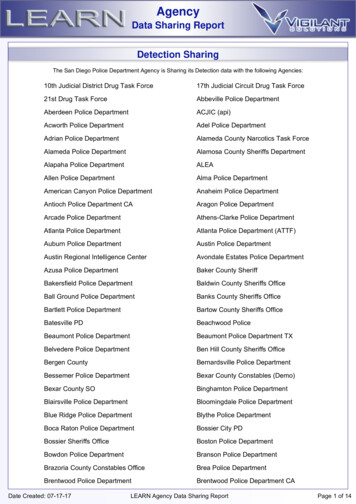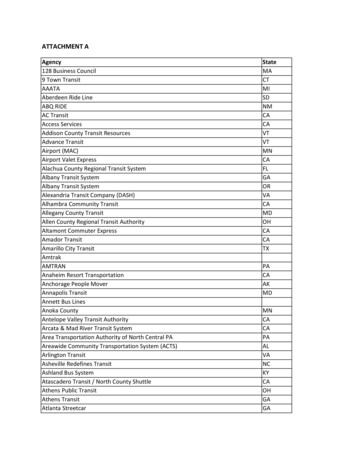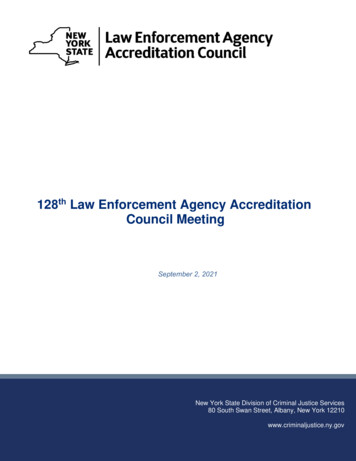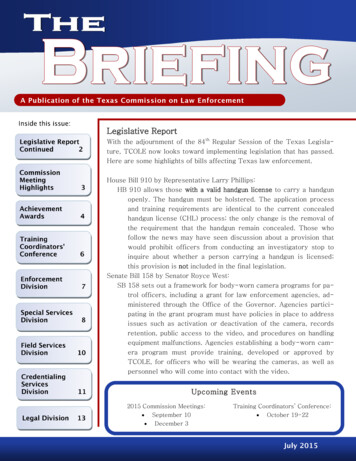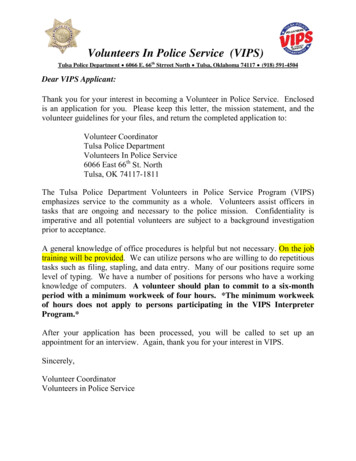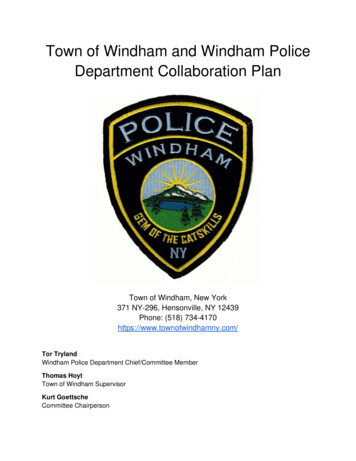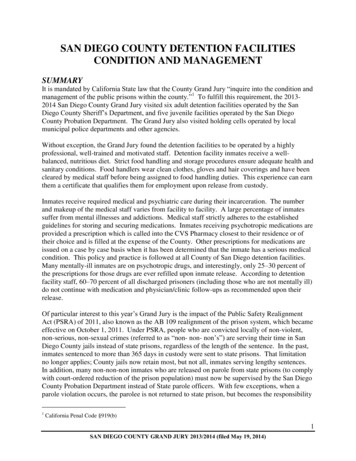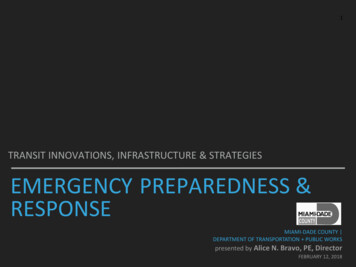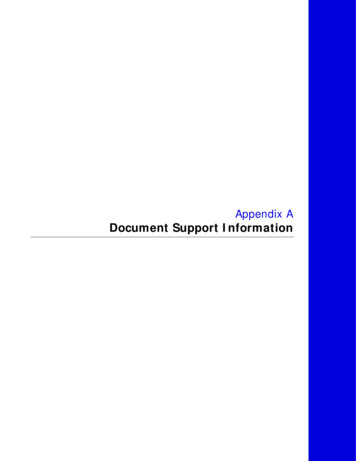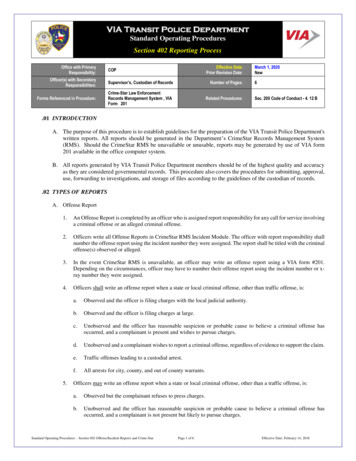
Transcription
VIA Transit Police DepartmentStandard Operating ProceduresSection 402 Reporting ProcessOffice with PrimaryResponsibility:Effective Date:Prior Revision Date:COPOfficer(s) with SecondaryResponsibilities:Supervisor’s, Custodian of RecordsNumber of Pages:Forms Referenced in Procedure:Crime-Star Law EnforcementRecords Management System , VIAForm 201Related Procedures:March 1, 2020New6Sec. 200 Code of Conduct - 4. 12 B.01 INTRODUCTIONA. The purpose of this procedure is to establish guidelines for the preparation of the VIA Transit Police Department'swritten reports. All reports should be generated in the Department’s CrimeStar Records Management System(RMS). Should the CrimeStar RMS be unavailable or unusable, reports may be generated by use of VIA form201 available in the office computer system.B. All reports generated by VIA Transit Police Department members should be of the highest quality and accuracyas they are considered governmental records. This procedure also covers the procedures for submitting, approval,use, forwarding to investigations, and storage of files according to the guidelines of the custodian of records.02 TYPES OF REPORTSA. Offense Report1.An Offense Report is completed by an officer who is assigned report responsibility for any call for service involvinga criminal offense or an alleged criminal offense.2.Officers write all Offense Reports in CrimeStar RMS Incident Module. The officer with report responsibility shallnumber the offense report using the incident number they were assigned. The report shall be titled with the criminaloffense(s) observed or alleged.3.In the event CrimeStar RMS is unavailable, an officer may write an offense report using a VIA form #201.Depending on the circumstances, officer may have to number their offense report using the incident number or xray number they were assigned.4.Officers shall write an offense report when a state or local criminal offense, other than traffic offense, is:5.a.Observed and the officer is filing charges with the local judicial authority.b.Observed and the officer is filing charges at large.c.Unobserved and the officer has reasonable suspicion or probable cause to believe a criminal offense hasoccurred, and a complainant is present and wishes to pursue charges.d.Unobserved and a complainant wishes to report a criminal offense, regardless of evidence to support the claim.e.Traffic offenses leading to a custodial arrest.f.All arrests for city, county, and out of county warrants.Officers may write an offense report when a state or local criminal offense, other than a traffic offense, is:a.Observed but the complainant refuses to press charges.b.Unobserved and the officer has reasonable suspicion or probable cause to believe a criminal offense hasoccurred, and a complainant is not present but likely to pursue charges.Standard Operating Procedures – Section 402 Offense/Incident Reports and Crime-StarPage 1 of 6Effective Date: February 14, 2018
VIA Transit Police DepartmentStandard Operating ProceduresSection 402 Reporting ProcessB. Incident Report1.An Incident Report is completed by an officer with report responsibility for a call for service with the needto document, investigate, forward any incident.2.Officers write all Incident reports in CrimeStar RMS Incident Module. The officer with report responsibilityshall number the incident report using the incident number they were assigned. The officer shall title the incidentreport with a title that closely resembles their scenario. Incident reports should not be titled with a criminal offensenor involve criminal offenses.3.In the event CrimeStar RMS is not available, an officer may write an incident report using a VIA form #201.Depending on the circumstances, officers may have to number their incident report using the incident number orthe x-ray number they were assigned.4.Officers shall write an incident report when a call for service requires the documentation of:5.a.The tow of a vehicle in parking offenses or traffic offenses not leading to a custodial arrestb.The use of force, above soft empty hand control, not leading to an arrest.c.Emergency detentions.d.Criminal trespass warnings.e.The death of an individual on transit system or involving any VIA vehicle.f.The loss of personal property a complainant wishes to document.g.The finding of property that cannot be taken or stored at VIA’s lost and found or returned to the owner.Officers may write an incident report when a call for service could possibly need documentation involving:a.Disturbancesb.Suspicious persons, vehicles, or activity.c.Sickness or injuries on or involving the transit system.C. Supplemental Report1.The Supplemental Report is an additional report attached the original offense or incident report. There is nolimit to the amount of supplemental reports that can be added to an original report. The supplemental reportserves to add additional information to an existing case or to make corrections to existing record.2.Officers shall write a supplemental report when:a.The officers are a part of a call for service that leads to a felony arrest.b.The officers have information or witness information relating to the probable cause of a criminaloffense.c.The officers have information or witness information relating to the witness testimonies of a criminaloffense.Standard Operating Procedures – Section 402 Offense/Incident Reports and Crime-StarPage 2 of 6Effective Date: February 14, 2018
VIA Transit Police DepartmentStandard Operating ProceduresSection 402 Reporting Process3.d.The officers have information or witness information relating to the statements, actions, or defense of asuspect in a criminal offense.e.the officer has additional information for the original report however the report has been locked by asupervisor.f.a copy of the original report has been submitted to the local judicial authority and a correction,addition, or change needs to be made to the original report.g.a complainant has additional information relating to their case and reports it to an additional officer.f.instructed to do so by an investigator, supervisor, or commanding officer.All Supplemental Reports must be included in the case record. The case record is not considered completewithout all required supplements prepared by officers for the original report.D. Assist Outside Agency Report1.The Assist Outside Agency (AOA) Report can be either an offense report or incident report in nature. Assuch, the procedures for both 402.02A and 402.02B can apply to these types of reports.2.They are reports written for the for the need to document a situation that the VIA Metropolitan Transit PoliceDepartment is not leading the follow-up investigation.3.Assist outside agency reports are, submitted, reviewed, approved, and forwarded to investigations in the samemanner as offense or incident reports.E. Administrative Report1.2.Officers required to write a report that will be used for administrative purposes only shall not write the reportin Crime-Star nor assign a case number. Administrative reports should be written in memorandum form.Examples of Administrative Reports are:a.Requests for training and/or travel.b.Requests for shift/relief day changes.c.All Internal Investigation Reports.All reports regarding internal disciplinary cases shall be considered Administrative Reports and be dealt within hard copy only.03 RESPONSIBILITY AND PROCEDURE FOR TURNING IN REPORTSA. All incident numbers requested by officers shall have a corresponding report submitted.B. All Reports prepared by a Transit Police Officer in CrimeStar RMS shall be submitted prior to the end of theofficer’s respective shift except under extenuating circumstances and with the approval of a supervisor.C. Should handwritten reports become necessary, the case is logged in and the hard copy is turned into the reportbox located in the Transit Police Department offices. Copies of the report should be routed to the Transit PoliceInvestigator when the officer deems the incident a high-priority case.D. In the event CrimeStar RMS is unavailable, it is the responsibility of the individual who hand wrote the report toelectronically submit it when CrimeStar becomes available.Standard Operating Procedures – Section 402 Offense/Incident Reports and Crime-StarPage 3 of 6Effective Date: February 14, 2018
VIA Transit Police DepartmentStandard Operating ProceduresSection 402 Reporting ProcessE. All officers submitting reports through CrimeStar shall enter the internal disposition and UCR disposition as“OPEN”.04. APPROVING AUTHORITYA. Supervisors shall conduct daily inquires for new reports that have not been reviewed from officers under theirdirect supervision or for officers creating reports during their shifts.B. Supervisors shall inspect all reports for completeness, accuracy, and validity. Upon inspection, each supervisorwill claim which report they reviewed, the date they reviewed it, and update the reviewed status of the report.C. If the report is reviewed but not approved the supervisor shall “kickback” the report and explain to the officer,the corrections needed. If the report has already been submitted to the local judicial authority, the officer shall beinstructed to write a supplement with the corrections.D. All reports already submitted to the local judicial authority must be locked as soon as the supervisor becomesaware the report has been submitted. Locked reports can still be reviewed and not approved.E. Once a report is reviewed and approved the supervisor shall select the internal disposition, the UCR dispositionand the date of the disposition for the report. Supervisors must choose the disposition as it closely relates to thescenario the report has described. All approved reports must be locked under the case management report to avoidalteration to the original report.F.If the report meets criteria to assign to an investigator as defined in SOP 402.05 the supervisor shall make theinvestigation active and assign an investigator to the report in their case management. Report will only be assignedto a VIA Metropolitan Transit Police Detective Investigator.G. All unapproved reports shall be corrected by the author of the report immediately.H. Supervisors shall conduct a weekly inquiry for missing incident reports in their case management. Supervisorsshall search for missing incident numbers generated from the calls for service log that are not found in the incidentmodule. If an incident report is determined to be missing, the supervisor shall conduct an investigation for eachmissing incident report generated by officers assigned on their shift. The supervisor shall discover the officerresponsible for writing the report and take the appropriate action to correct the error. All reports must besubmitted, returned, corrected and finally approved no later than seven (7) calendar days from the date of theoriginal call for service.05 REPORTS REQUIRING ASSIGNMENT OF INVESTIGATORA. During the review of the reports in the case management, Supervisors will come across reports needing followup investigation. Reports needing follow-up investigation shall be assigned an investigator. Supervisors shalldesignate an investigation active and assign an investigator, in their case management, for reports meeting thefollowing criteria:1.Offense reports with a felony offense and a suspect has been arrested.2.Offense reports with a felony offense higher and a suspect has been identified.3.Offense reports with a misdemeanor offense and a suspect has been arrested.4.Offense reports with a misdemeanor offense and a suspect has been identified.5.Any report the supervisor deems has a high probability of solvability.Standard Operating Procedures – Section 402 Offense/Incident Reports and Crime-StarPage 4 of 6Effective Date: February 14, 2018
VIA Transit Police DepartmentStandard Operating ProceduresSection 402 Reporting Process6.Any report with suspected workplace violence.B. Officers may be faced with the need to have a case investigated for a variety of reasons. Officers may forwardthe report to the investigator and notify their supervisor. NOTE: Simply forwarding the report or case number tothe investigator does not automatically assign the report to the investigator’s workload.06 MAKING CHANGES ON POLICE REPORTSA. Officers may make changes to their reports that have not been approved or locked by a supervisor or submittedto the local judicial authority.B. All changes, corrections, or additional information needed to be added to an original report shall be done throughthe use of a supplemental report if a copy of the original report has already been submitted to the local judicialauthority.C. No officer shall make changes, alterations, or corrections to another officer’s report. Suggestions to anotherofficer’s report will be made to the officer themselves. This does not apply to shared documents such as propertyand evidence which requires the need for multiple officers to add to chain of custody. Nor does it apply to mastername, location, or vehicle index which has a necessity to be updated. Updates by other officers shall be donethrough their respective modules not through the body of another officer’s report.D. Supervisors shall not make changes to another officer’s reports. Changes requested or required by the supervisormust be made through the case management. Reports needing changes shall be submitted by the supervisorthrough kickback messages.07 INTERNAL DISPOSITIONA. All reports shall be closed out with an internal disposition. The responsibility of entering the internal dispositionfalls on the officer writing the report. All officers shall enter every disposition “open” regardless if they know theoutcome of their report.B. Supervisors are responsible for changing the disposition at the time the report has been approved. Supervisors shallchange the disposition using their case management. Internal dispositions to reports should be labeled bysupervisors in the following scenarios:1.Closed - All incident reports should be “closed” when approved. No reports meeting SOP 402.05 shall beclosed by a supervisor.2.Open - All reports meeting SOP 402.05 shall remain “open” by a supervisor. The assigned investigator shallhave final say towards the disposition.3.Suspended - Offense reports with no leads and do not meet criteria per SOP 402.05, should be suspended.4.Filed – Offense reports that do not meet criteria outlined in SOP 402.05 and concluded with a citation only,shall be listed as filed with the court.C. The Transit Police Investigators are responsible for the final dispositions of reports assigned to them. Investigatorsshall make changes to the disposition using their case management. Investigators will use the internal dispositionto manage which cases are being investigated and which are no longer being investigated. Internal dispositions toreports should be labeled by the investigator in the following scenarios:1.Closed – All offense or incident reports which lead the investigator to believe the complaint is unfounded,baseless or untruthful. Offense reports leading to a conviction of a suspect and offenses exceeding the statutesof limitation should be closed. When closing a report, investigators should remove the “investigation active”status from the report and therefore remove the report from their workload.Standard Operating Procedures – Section 402 Offense/Incident Reports and Crime-StarPage 5 of 6Effective Date: February 14, 2018
VIA Transit Police DepartmentStandard Operating ProceduresSection 402 Reporting Process2.Open – All reports the investigator is still investigating.3.Suspended- Cases where a crime has been established, yet all leads to solve the crime have been exhausted.The leads have not yielded the combination of probable cause and a suspect. Suspended cases can be reopenedif further leads develop. When a report has been suspended by an investigator, the investigator should removethe “investigation active” status from the report and therefore remove the report from their workload.4.Filed – All case reports the investigator has turned over to the assistant district attorney and/or courts. Whena report has been filed with a local judicial authority, the investigator should remove the “investigation active”status from the report and therefore remove the report from their workload.08 UNIFORMED CRIME REPORT DISPOSITIONSA. Officers creating the report shall enter in a UCR Disposition to all reports they create. Officer shall enter in a UCRdisposition of “Open” for all reports, regardless if they know the conclusion to their reports.B. Supervisors shall update the UCR disposition after reviewing and approving the report. Supervisors shall update theUCR disposition regardless if it meets criteria listed in SOP 402.05.C. Investigators shall be responsible for the final entry to the UCR disposition for all reports assigned to them.Investigators will update the UCR disposition based on the developments in the case.D. Investigators and supervisor will assign a UCR disposition based on the report using the following guidelines:1.Open- Indicates the report is still being investigated.2.Cleared by Adult Arrest- indicates for UCR purposes, the report has been cleared. In reports with multiplesuspects, the arrest of any one adult suspect is sufficient to clear the report using CBAA.3.Cleared by Juvenile Arrest- indicates for UCR purposes, the report has been cleared. In reports with multiplesuspects, the arrest of any one juvenile suspect is sufficient to clear the report using CBJA.4.Cleared by Exception, Adult- indicates for UCR purposes, the report has been cleared. An adult exception wouldbe a circumstance where the suspect is an adult but due to the circumstances beyond the control of VIA TransitPolice Department, no arrest can be made. The department can clear by exception when the following questionscan be answered in the affirmative: Has the investigation established the identity of an offender?Is there enough information to support an arrest, charge, and turning over to the court forprosecution?Is the exact location of the offender known so the suspect can be taken into custody?Is there some sort of reason outside of law enforcement control that precludes arresting, charging,prosecuting the offender?5.Cleared by Exception, Juvenile- indicates for UCR purposes, the report has been cleared. A juvenile exceptionwould be a circumstance similar to that of a cleared by adult exception, but the suspect involved is a juvenilerather than an adult.6.Suspended- indicates the report is treated as open in that there is no UCR clearance. Using suspended indicatesthe department is no longer actively working or investigating the report, but the investigation has not been clearednor meets criteria to clear by exception.7.Unfounded- indicates the crime as reported was false or a baseless complaint and/ or no crime has occurred.Standard Operating Procedures – Section 402 Offense/Incident Reports and Crime-StarPage 6 of 6Effective Date: February 14, 2018
1. The Supplemental Report is an additional report attached the original offense or incident report. There is no limit to the amount of supplemental reports that can be added to an original report. The supplemental report serves to add additional information to an existing case or to make corrections to existing record. 2.
